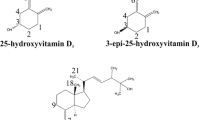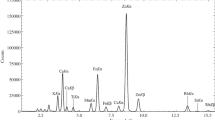Abstract
Two approaches were used to determine the mass fraction of a sample of folic acid, one indirect (mass balance) where the components other than folic acid were measured, and one direct, using quantitative nuclear magnetic resonance (qNMR). The procedures used for the mass balance were essentially those described in the European Pharmacopoeia monograph for folic acid. qNMR is a technique for quantifying the main component within an organic compound (Quantitative NMR (qNMR)—BIPM in https://www.bipm.org/en/bipm/chemistry/organic-analysis/qnmr/, Santosh and Raja in Trends Anal Chem 35:5–26, 2012), whereas mass balance quantifies its minor components. The results obtained with the two approaches are independent. In this study, their joint application generated information that was used in a more than complementary fashion. The mass balance characterisation, in particular the results obtained by liquid chromatography with ultraviolet detection (LC–UV), allowed to improve the accuracy of the qNMR result by subtracting the interfering contribution of a related structure impurity. On the other hand, qNMR enabled concluding that the non-uniform response of UV detection at a single wavelength was not critically biasing the LC–UV results. In the end, the mass fractions obtained by mass balance and qNMR were not that different. It is concluded that mass balance and qNMR may be not only complementary but also synergistic. It was also observed that access to monographs of the European Pharmacopoeia, when available, gives skilled analysts an important tool for improved substance characterisation.



Similar content being viewed by others
References
Quantitative NMR (qNMR)—BIPM. https://www.bipm.org/en/bipm/chemistry/organic-analysis/qnmr/. Last Consulted 20 Feb 2018
Santosh KB, Raja R (2012) Quantitative 1H NMR spectroscopy. Trends Anal Chem 35:5–26
BIPM CCQM Working Group on Organic Analysis (OAWG). https://www.bipm.org/en/committees/cc/wg/oawg.html. Last Consulted 09 Feb 2018
Ph. Eur. Reference Standard FOLIC ACID CRS batch 8, information leaflet. https://crs.edqm.eu/db/4DCGI/View=F0300000. Last Consulted 06 Dec 2017
Ph. Int. Reference Standard FOLIC ACID ICRS batch 3, information leaflet. https://crs.edqm.eu/db/4DCGI/View=ICRS0316. Last Consulted 6 Dec 2017
Council of Europe (2016) Folic acid. In: European Pharmacopoeia, 9th edn. Strasbourg, France, pp 2524–2526
Council of Europe (2015) Folic acid dihydrate, Draft monograph. In: Pharmeuropa, vol 27, issue 4. Strasbourg, France, pp 91–96
Council of Europe (2016) Semi-micro determination of water (chapter 2.5.12). In: European Pharmacopoeia, 9th edn. Strasbourg, France, p 165
Council of Europe (2016) Thermal analysis (chapter 2.2.34). In: European Pharmacopoeia, 9th edn. Strasbourg, France, pp 57–59
Council of Europe (2016) Water micro-determination (chapter 2.5.32). In: European Pharmacopoeia, 9th edn. Strasbourg, France, p 172
Council of Europe (2016) Reagents (4.1.1). In: European Pharmacopoeia, 9th edn. Strasbourg, France, pp 441–559
Council of Europe (2016) Identification and control of residual solvents (2.4.24). In: European Pharmacopoeia, 9th edn. Strasbourg, France, pp 146–150
Council of Europe (2016) Sulfated ash (2.4.14). In: European Pharmacopoeia, 9th edn. Strasbourg, France, p 136
Davies S, Jones K, Goldys A et al (2015) Purity assessment of organic calibration standards using a combination of quantitative NMR and mass balance. Anal Bioanal Chem 407:3115–3123
Council of Europe (2016) Chromatographic separation techniques (chapter 2.2.46). In: European Pharmacopoeia, 9th edn. Strasbourg, France, pp 74–81
Acknowledgements
The authors wish to thank Dr S. Westwood (BIPM) for giving the EDQM Laboratory the opportunity to participate in the pilot study. The authors are also thankful to Dr M. Weber and Ms S. Moneret (EDQM Laboratory) for the scientific advice provided.
Conflict of interest
The authors declare that they have no conflict of interest.
Author information
Authors and Affiliations
Corresponding author
Additional information
Disclaimer: The name and make of commercial equipment, instruments and materials used in this study are indicated at the request of the Editor. No particular commercial equipment, instruments, or materials cited in this paper are recommended or endorsed by the European Directorate for the Quality of Medicines and Healthcare (EDQM).
Rights and permissions
About this article
Cite this article
Lodi, A., Nap, CJ., Metzger-Maurer, S. et al. Characterisation of folic acid by mass balance versus quantitative NMR. Accred Qual Assur 23, 211–218 (2018). https://doi.org/10.1007/s00769-018-1327-7
Received:
Accepted:
Published:
Issue Date:
DOI: https://doi.org/10.1007/s00769-018-1327-7




